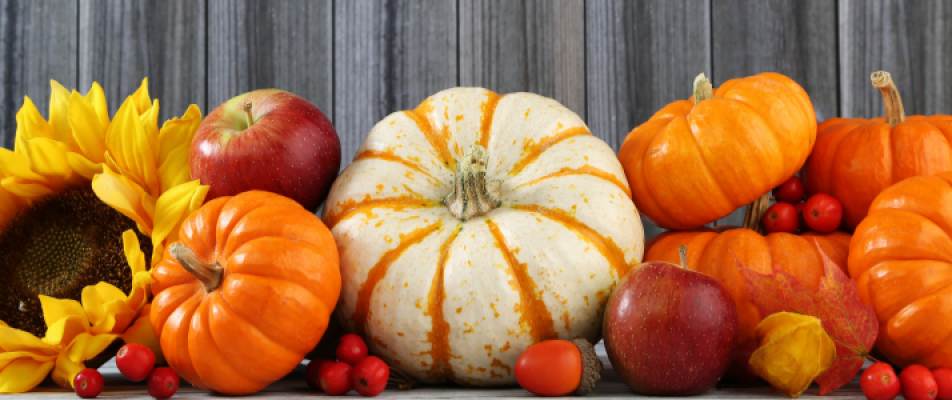
It’s Pumpkin Season!
Here’s how to cook with these beautiful, tasty gourds.
Did you know that pumpkin is in the same family as cucumbers and melons? Makes sense actually, all three have taken over my backyard garden in years past.
And that it is a fruit (because it has seeds). From a nutrition perspective, it is nutrient dense, acting more like a veggie than a fruit. Here’s a quick breakdown:
PUMPKIN
One cup of pumpkin contains the following:
137 Calories
3g Protein
7g Fat
19g Carbs
7g of Fiber
209% daily value (DV) of Vitamin A
37% DV Vitamin K
28% DV Copper
22% DV Vitamin E
18% DV Iron
13% DV Magnesium
10% DV Riboflavin
10% DV Vitamin B6
10% DV Vitamin C
10% DV Potassium
There is more, but those are the double-digit nutrients. So much goodness in there!
PUMPKIN SEEDS
Pumpkin seeds, or pepitas, are also commonly eaten as a snack. Here’s the nutrient breakdown.
1 ounce (about a large handful) contains:
86 Calories
4g Protein
7g Fat
2g Carbs
1g Fiber
21% DV Copper
20% DV Magnesium
14% DV Phosphorus
10% DV Zinc
This is a relatively low carb, higher fat snack that will keep you nice and satisfied.
About Vitamin A
The Vitamin A is impressive – especially because it’s partly beta carotene (which is the precursor to Vitamin A and a big antioxidant. Eating pumpkin will help keep you healthy as the weather turns cold. Vitamin A also helps maintain good gut health and is a powerful player in eye health. The beta carotene maintains vision by helping the retina absorb light. The other nutrients protect against macular degeneration.
A Look at Metabolic Health
High beta carotene is also associated with blood sugar control, which helps keep the muffin top away. The higher fiber dulls blood sugar spikes, giving you energy for longer periods without the peak/valley blood sugar problem.
NOTE: All of this healthy pumpkin talk does NOT apply to the sugary pumpkin spiced drinks or other “pumpkin” processed foods!
Here are some delicious ways to include pumpkin in your diet this season. Recipes are always gluten free, dairy free and free of processed sugars.
Pumpkin Pie Chia Pudding
Modified from Savory Lotus
A delicious breakfast or snack.
2 cups milk (nut-based, oat-based)
1 cup cooked pumpkin puree (canned is fine)
3 tbsp maple syrup
1 tsp vanilla extract
1/2 tsp cinnamon powder
1/4 tsp ginger powder
1/4 tsp allspice
4–6 tbsp chia seeds
Toppers: berries, shredded coconut, chopped nuts
Place all ingredients, except for chia seeds, into a blender and puree until smooth. Pour chia seeds into glass jar, pour pumpkin pie flavored liquid over seeds. Place cap on jar and mix well. Place in fridge overnight or for several hours. (More chia means thicker pudding, less means more liquid-y).
Pumpkin Pie Spiced Creamer (dairy free, no extra processed sugar)
Whole New Mom
Up your fall home coffee game.
1/2 cup cashews
2-3 cups water
2 tbsp maple syrup
2 tsp pumpkin pie spice
1 tsp vanilla
Place cashews in a container and cover with water for a few hours (2-4). Drain nuts and place in a blender. Add enough new water to just cover the nuts. Add syrup and spices and blend again.
Spicy Toasted Pumpkin Seeds
She Wears Many Hats
An easy grab-and-go snack.
1 cup pumpkin seeds, rinsed and dry
½ tsp garlic powder
½ tsp sea salt
½ tsp cracked black pepper
½ tsp paprika
¼ tsp cayenne powder (optional)
2 tbsp olive oil
Preheat oven to 350 degrees. In a bowl combine all ingredients until seed are coated well. Spread evenly on a baking sheet with parchment paper. Bake until toasted and slightly browned, about 15-20 minutes, tossing halfway through.
For more healthy seasonal tips and recipes, visit healthynestnutrition.com/blog/. Need a hand finding your personalized nutrition plan? Book a free 20-minute consultation with Healthy Nest Nutrition owner Robin Hutchinson to see if our programs are right for you.
